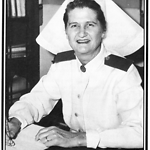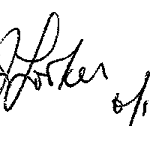Person
Guy, Margaret Frances (1910 - 1988)
OBE

Margaret Frances Guy
Details
- Born
- 10 October 1910
Tasmania, Australia - Died
- 25 August 1988
- Occupation
- Nurse, Nurse administrator and Nurse educator
- Alternative Names
- Looker, Margaret Frances (maiden name)
Summary
Margaret Frances Guy qualified as a nurse in 1937, and served with the Army Nursing Service during the Second World War. The recipient of a number of grants (Rotary, Fulbright, and the first Churchill Fellowship awarded to a woman) she undertook studies in the UK and USA in nurse education and administration. She was one of four founders of the New South Wales College of Nursing in 1949. At the time of her appointment to the Royal Prince Alfred Hospital, New South Wales, in 1948, she was the youngest Matron in Australia. Margaret Guy is remembered as a skilful administrator and passionate educator. In 1961 she was appointed an Officer of the Order of the British Empire (OBE) for services to nursing.
Details
Margaret Frances Guy (née Looker) was born 10 October 1910, in Tasmania (she was named Martha Fannie) and died 25 August 1988 in Canberra, ACT. A memorial service was held at the Royal Canberra Hospital, 25 August 1988. She married John Guy in England in December 1955. In 1937, Miss Looker, as she was then, received her General Nursing Certificate from the Royal Prince Alfred Hospital in New South Wales, and took up a position in the same year as Charge Nurse at the hospital. The following year, 1938, she was a sister with the School Medical Service and in 1939 completed her Midwifery Certificate at the Crown Street Women's Hospital, Sydney. After service with the Army Nursing Service during the Second World War, in which she achieved the rank of captain, she travelled to London to study. In June 1947 she was awarded a Sister Tutor Diploma, Royal College of Nursing, London, UK and in November of the same year Part A, Diploma of Nursing, from the University of London, UK. In 1955 she received a Diploma of Nursing Administration from the University of Chicago, Illinois, USA. A member of the Florence Nightingale Memorial Committee (New South Wales) she was recognised in 1946-47 as the Foundation Florence Nightingale (International) Scholar for New South Wales. Her studies in the USA, 1954-55, were facilitated by Rotary and Fulbright Travel Grants, and she was the first woman to receive a Churchill Fellowship in 1966.
Margaret Guy was one of four founders of the New South Wales College of Nursing (NSWCN) serving as Vice-President of the Provisional Council 19 May 1949 to 31 January 1950; Vice-President 1 July 1951 to 4 November 1952; President 4 November 1952 to 8 July 1953 (resigning to take up Travel Grant). She was recognised as a Founder and invested as Foundation Fellow, 18 September 1952, delivering the Annual Oration, 'The Practice of Nursing', on 16 September 1964. A supervisor of the Sister Tutor Diploma 1949, she convened the first Sister Tutor Conference in 1951 and acted as assistant convenor of the first Ward Sisters Conference, 1951. In 1961 she was awarded the OBE for services to nursing.
Chronology
- 1937
- General Nursing Certificate completed at the Royal Prince Alfred Hospital, New South Wales
- 1937 - 1938
- Sister at the School Medical Service, New South Wales
- 1938 - 1939
- Sister at the Royal Prince Alfred Hospital
- 1939
- Midwifery Certificate completed at the Crown Street Women's Hospital in Sydney
- 1940 - 1946
- Lieutenant and later Captain in the Army Nursing Service
- 1946 - 1947
- Sister at St Thomas's Hospital in London and Queen Elizabeth Hospital in Birmingham, UK
- 1948 - 1954
- Matron and Superintendent of Nursing at the Royal Prince Alfred Hospital, New South Wales
- 1955
- Tutor Sister in Winchester, UK
- 1956 - 1972
- Matron at Canberra Community Hospital (early retirement due to ill health)
Archival resources
National Library of Australia Manuscript Collection
- Biographical cuttings on Margaret Guy, Cuttings Files BIOG; National Library of Australia Manuscript Collection. Details
Published resources
Encyclopedia of Australian Science and Innovation Exhibitions
- McCarthy, Gavan; Morgan, Helen; Smith, Ailie; van den Bosch, Alan, Where are the Women in Australian Science?, Exhibition of the Encyclopedia of Australian Science and Innovation, First published 2003 with lists updated regulary edn, Australian Science and Technology Heritage Centre, Melbourne, Victoria, 2003, https://eoas.info/exhibitions/wisa/wisa.html. Details
Conference Papers
- Guy, Margaret F., 'The Practice of Nursing [delivered by Margaret F. Guy]', in Twelfth Annual Oration (New South Wales College of Nursing) (Glebe, NSW: New South Wales College of Nursing, 1964), p. 4.. Details
Resources
- 'Looker, Margaret Frances (19101014-19880825)', Trove, National Library of Australia, 2009, https://nla.gov.au/nla.party-755095. Details
Resource Sections
- 'Guy, Margaret Frances (1910-1988), Biographical Entry', in Australian Women's Archives Project, National Foundation for Australian Women, 2002, http://www.womenaustralia.info/biogs/IMP0105b.htm. Details
See also
- Newman, Janet and Warren, Jennie eds, Royal Canberra Hospital: an Anecdotal History of Nursing 1914 to 1991 (Mawson, ACT: Janet Newman and Jennie Warren, 1993), 430 pp. Details
Digital resources
Australian Nursing History Project, Judith Cornell
Created: 8 February 2002, Last modified: 4 June 2010
- Foundation Supporter - The College of Nursing (Incorporating The New South Wales College of Nursing)

